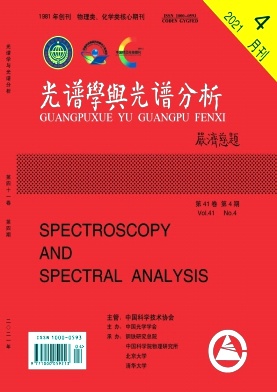光谱学与光谱分析, 2021, 41 (4): 1011, 网络出版: 2021-04-12
超连续光谱细胞无损伤非侵入式检测技术的研究
Research on Nondestructive and Noninvasive Detection Technology of Cells Based on Supercontinuum Spectrum
摘要
中国在庞大的人口基数下拥有丰富的遗传资源, 这些资源可能被国外非法掠夺以获取利益, 非法掠夺的过程揭示可能存在一些安全隐患, 例如传染疾病的扩散等。 如何加强对中国公民遗传资源的保护, 促进国际间正常合法的信息共享和科研合作已成为生物安全的新问题。 为加强人体细胞及其制品等特殊生物物品出入境管理, 防止遗传资源流失和有害物品传入, 促进各个国家间医学科学研究及国际交流与合作, 提出一种非侵入、 快速安全的细胞光谱鉴别技术。 简述了细胞超连续光谱的物理化学机制, 讨论了细胞浓度对超连续光谱的影响, 实现了无损伤、 非侵入式探测提取生物细胞超连续特征光谱。 实验发现细胞超连续特征光谱主要集中在500~700 nm的可见区域。 实验中的细胞样本均为单独培养, 因此各个样本间互不影响, 不存在平行样本的问题; 实验对象为293T细胞、 HCC827细胞以及HT29细胞, 3类细胞的培养基均为PBS溶液, 每类细胞拥有3种浓度(5×105, 5×106和5×107 cells·mL-1)且每种浓度下独立培养3个样本, 一共获取27个独立细胞样本。 实验测试了24个细胞样本的超连续光谱并以此建立预测模型, 另有3个样本作为未知样本进行模型预判。 使用主成分分析法对测试样本的原始数据进行降维和聚类, 并对降维后的数据通过支持向量机回归法进行分类; 训练集的均方根误差RMSE=0.097 2, R2=0.995 1, 验证集的均方根误差为RMSE=0.097 2, R2=0.931 4。 研究发现细胞浓度影响超连续特征光谱的提取, 在建立模型时, 考虑到该技术应用的普适性以及实验样本浓度参数有限, 未考虑细胞浓度对预判模型识别率的影响。 后期若以某一浓度阈值作为细胞检测的浓度起点, 该模型的识别率将会更准确、 科学。 在可控的实验条件下, 超连续光谱可以应用于生物细胞无损伤、 非侵入式的鉴别。
Abstract
China has abundant genetic resources under the huge population base. Foreign countries may illegally plunder these resources to obtain benefits. There may be some security risks in the process of illegal plunder, such as the spread of infectious diseases. It has become a new problem of biosafety to strengthen the protection of Chinese citizens’ genetic resources and promote normal and legal international information sharing and scientific research cooperation. In order to strengthen the entry and exit management of human cells and their products, prevent the loss of genetic resources and the introduction of harmful substances, and promote medical scientific research and international exchange and cooperation among various countries, a non-invasive, fast and safe cell spectral identification technology is proposed. In this paper, the physicochemical mechanism of cell supercontinuum is described, the effect of cell concentration on the supercontinuum is discussed, and the non-invasive detection and extraction of the supercontinuum fingerprint spectrum of biological cells is realized. The experimental results show that the supercontinuum fingerprint spectrum of cells is mainly concentrated in the visible region of 500~700 nm. The cell samples in the experiment are all cultured separately, so there is no influence between the samples. The subjects of the experiment are 293T cells, HCC827 cells and HT29 cells. The medium of the three types of cells in PBS medium, each type of cell has three concentrations (5×105, 5×106, 5×107 cells·mL-1) and three samples are cultured independently under each concentration, a total of 27 samples are obtained individual cell samples. The supercontinuum spectra of 24 cell samples were tested and a prediction model was established. Another three samples were used as unknown samples for model prediction. The principal component analysis is used to reduce the dimension of the test samples’ original data, and the reduced dimension data are classified by support vector machine regression. The root mean square error of the training set is 0.097 2, R2=0.995 1, and the root mean square error of the verification set is 0.097 2, R2=0.931 4. It is found that cell concentration affects the extraction of the supercontinuum fingerprint spectrum. In this paper, when building the model, considering the universality of the application of the technology and the limited concentration parameters of the experimental samples, the influence of cell concentration on the recognition rate of the prediction model is not considered. In the later stage, if a certain concentration threshold is taken as the concentration starting point of cell detection, the recognition rate of the model will be more accurate and scientific. Under controlled experimental conditions, supercontinuum spectroscopy can be applied to noninvasive and noninvasive identification of biological cells.
王泓鹏, 方沛沛, 马焕臻, 万雄, 贾建军, 何志平, 凌宗成. 超连续光谱细胞无损伤非侵入式检测技术的研究[J]. 光谱学与光谱分析, 2021, 41(4): 1011. WANG Hong-peng, FANG Pei-pei, MA Huan-zhen, WAN Xiong, JIA Jian-jun, HE Zhi-ping, LING Zong-cheng. Research on Nondestructive and Noninvasive Detection Technology of Cells Based on Supercontinuum Spectrum[J]. Spectroscopy and Spectral Analysis, 2021, 41(4): 1011.



